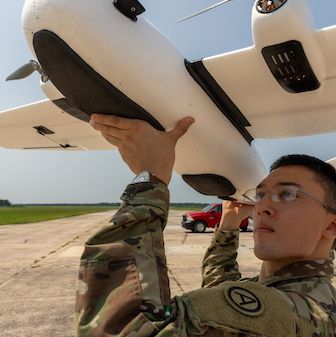The Army is turning to the crowd, and the cloud, to detect hostile drones. CARPE Dronvm is an app that users will soon be able to download that can identify drones—and alert authorities if necessary. The app was recently tested by Task Force 39, an arm of the U.S. Army tasked with helping counter the threat of hostile drones to soldiers serving in the Middle East.
The Active Drone Threat
One of the most dangerous places in the U.S. military right now is in the Middle East as part of Operation Inherent Resolve. The operation, tasked with eliminating remnants of the Islamic State, involves several hundred troops stationed in Syria. But soldiers and airmen have come under repeated attacks by drones, including an April 2022 attack on Al Asad Air base in Iraq, the August 2022 attack on the base at At-Tanf, Syria, and another attack at At-Tanf in January 2023.
Task Force 39, an Army unit dedicated to coming up with innovative ideas to support Inherent Resolve, recently sponsored a test of the CARPE Dronvm mobile phone app. The app, developed by the MITRE Corporation with Department of Defense funding, allows users to take photographs of unfamiliar drones and then send them, as MITRE explains, to a “processing engine (running a computer-vision machine learning algorithm) to determine if the picture contains a drone and to calculate its location.”
If a drone is detected, its location is geolocated on a situational awareness map at the command center. Other CARPE Dronvm users within a preset distance are alerted to the drone’s presence.
A Global Network of Sensors
The app takes advantage of the sheer number of smartphones spread across the planet. There are an estimated 5.2 billion smartphones worldwide, all of which have both a camera and internet connectivity. That effectively turns each phone into a networked sensor. CARPE Dronvm takes advantage of that global network, turning every smartphone in existence into a potential drone detector. MITRE says CARPE Dronvm will be available for both iOS and Android operating systems.
During the recent test, a drone flew a 31 mile route from McEntire Joint National Guard Base to Poinsett Electronic Combat Range, South Carolina. Soldiers with government-supplied smartphones were stationed along the drone’s route. As the drone flew by, the soldiers took photos and uploaded them to the app’s server for analysis and classification. A simulated command center at Poinsett collected the sightings and displayed them on the system’s situational awareness map.
A system like CARPE Dronvm grows more useful the more people have it. One downside is the bigger the crowd being sourced, the more data to sift. An advantage of CARPE Drovm is it’s cheap. That’s a big plus in drone detection, where the U.S. and its allies must work to counter inexpensive drones that, outfitted with explosive payloads, can cause a lot of damage.
Any effort to detect those drones can easily become very expensive, eventually leading to a system in which the actual counter to the drone costs many times more than the drone itself.
Peacetime and Privacy
A few questions worth asking: if people in non-combat zones, such as the continental United States, download and use the app, where does the information go? Furthermore, not only does the command center collecting drone sightings have a photograph of the drone, it would also have the location of the user.
That’s not a big deal if you’re part of Operation Inherent Resolve, but for civilians that value their privacy that could be a real concern.

Kyle Mizokami is a writer on defense and security issues and has been at Popular Mechanics since 2015. If it involves explosions or projectiles, he's generally in favor of it. Kyle’s articles have appeared at The Daily Beast, U.S. Naval Institute News, The Diplomat, Foreign Policy, Combat Aircraft Monthly, VICE News, and others. He lives in San Francisco.















